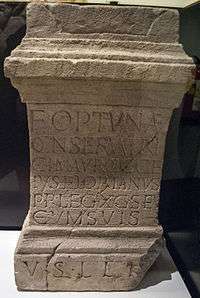Primus pilus
The Primus pilus or Primipilus was the senior centurion of the first cohort in a Roman legion.[1]
 | |
| Part of a series on the | |
| Military of ancient Rome | |
|---|---|
|
|
|
| |
Name
The origin of the name is very ancient: it used to be the commander of the first maniple of third line (triarii) of early republican Roman armies.[2] A common, but wrong translation of "primus pilus" is "first spear",[3] however a much more accurate translation would be "first pillar" since the word "pilus", sometimes confused with "pilum" or javelin, is a specific term to indicate the weapon of the triarii (a spear, not a javelin).
Historical role

In the late Roman republic, the cohort (of which there were between six and ten) became the basic tactical unit of the legions. The cohort was composed of five to eight centuries, each led by a centurion assisted by an optio, a soldier who could read and write. The senior centurion of the legion and commander of the first cohort was called the primus pilus, a career soldier and advisor to the legate. While every normal cohort was composed of five to eight centuries (normally six in secondus to decius cohorts), the one that was led by the primus pilus (the first) had about ten centuries, or 800 men. It also had a number of other staff, such as cooks, clerks, etc.; that is, non-combatants. In modern infantry ranks, primus pilus would be considered a lieutenant colonel in relation to battalion-size units, though there is no direct corresponding equivalent.
Only eight officers in a fully officered legion outranked the primus pilus: The legate (lēgātus legiōnis), commanding the legion; the senior tribune (tribunus laticlavius); the Camp Prefect (praefectus castrorum); and the five junior tribunes (tribuni angusticlavii).
Role in the war councils(minor edit)
The Primus Pilus centurion had a place in the war councils along with the military tribunes and the Legatus of the legion.
Off-Duty Life
Centurions usually have similar homes to the Cives Romani (full Roman citizen), but the higher ranked Centurions such as Primus Pilus usually have larger than usual homes. Other than that the centurion is no more than a Cives Romani. They have the right to vote, have property, have a wedding, and the right to hold office.
References